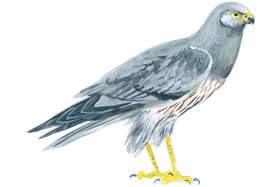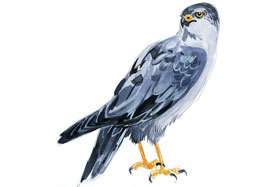
African Marsh-Harrier (Circus ranivorus)
Afrikaans: Vleivalk
The African Marsh-Harrier prefers the more well-watered, inland wetlands than the habitats Kruger has to offer, so it is rarely seen in the Park. It has been seen though at vleis during seasons of good rainfall. It usually hunts in the grasslands away from the marshes, flying above the veld at a height of between five and 10 metres looking for prey. The African Marsh-Harrier, like other raptors, breeds in winter.
The female keeps a meticulously clean nest and usually lays between three and six eggs. They hatch at intervals and although there is sibling competition for food, the oldest hatchling doesn't feel compelled to kill the others. They are very protective of their nests and will attack humans who come too close.
African Marsh-Harrier Characteristics
Adult Height
45-50cm
Weight
430-570g
Wingspan
88-94cm
Distinctive white crown and chestband on otherwise dark body; barred tail.Rare Vagrant
Prey
Rats and other small rodents, frogs and birds like pigeons, ruffs, teals; partial to raiding nests for eggs and is known to take fish out of streams.
Where best to find them
Wetlands along the edge of the southern Lebombo, particularly at the base of Muntshe Hill near Lower Sabie and in the vleis in the Mpanamana Concession.
Montagu's Harrier (Circus pygargus)
Afrikaans: Blouvleivalk
Montagu's Harrier is not uncommon in the grasslands, although some experts believe the population is either dwindling or its range is shrinking. It is an occasional summer migrant from Eurasia, usually arriving in September and departing again in March. It has narrow, long wings, which enable it to glide effortlessly for long stretches low over the veld - usually not more than three metres above the ground - as it searches for prey.
Montagu's Harrier Characteristics
Adult Height
40-47cm
Weight
260-370g
Wingspan
1.05-1.2m
Grey bird with streaked belly; yellow legs and, when in flight, black wingtips and secondaries; long, narrow wings.Migrant
Prey
Mostly small rodents, amphibians and insects.
Where best to find them
Open, drier grasslands of eastern and northern Kruger.
Pallid Harrier (Circus macrourus)
Afrikaans: Witborsvleivalk
The Pallid Harrier is an uncommon summer migrant arriving usually in November and departing in February for its breeding grounds on the Russian Steppes. It is often found in association with Montagu's Harrier. Both share a fondness for the same habitat - open savannah. The Pallid Harrier flies low over the grass and feeds on insects and small birds. It differs from Montagu's in that it has a plain, white belly, not a streaked one.
Pallid Harrier Characteristics
Adult Height
40-48cm
Weight
310-440g
Wingspan
0.95-1.2m
Grey upperparts and white underparts; yellow beak, eyes and legs; similar in appearance to Montagu's Harrier.Migrant
Prey
Small mammals, lizards, insects such as locusts, grasshoppers and beetles.
Where best to find them
Open savannah grasslands of eastern and northern Kruger.




